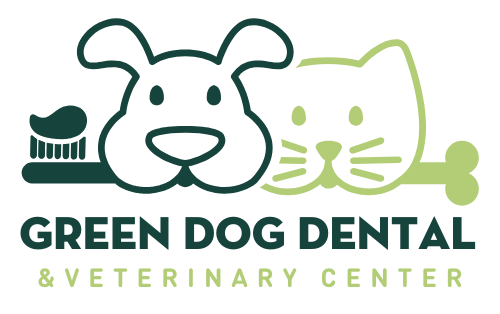
Diagnostic Imaging
Diagnostic Imaging (radiology) refers to using a variety of non-invasive technologies to acquire images in order to help make a diagnosis. There are a variety of advanced imaging machines and techniques available at Green Dog, including digital radiography (X-rays), Computed tomography (CT scan), and ultrasound. These are used to examine and evaluate different structures within your pets body. With consultation from radiologists Green Dog Doctors interpret the results of those images to assist in diagnosis or to guide other therapy.
There may come a time when your pet needs an advanced imaging study, such as X-rays, ultrasound, or computed tomography (CT scan). Green Dog is proud to be one of a very few out-patient clinics offering these services. Access to advanced technology is part of what drives great patient care. Green Dog has these technologies at our disposal, and we offer their use on an out-patient basis. If your pet needs an advanced imaging study, your veterinarian will recommend and schedule an appointment. (often same-day!)
Imaging Services:
- Computed Tomography (CT) Scanning
- Digital Ultrasonography
- Digital X-Ray Imaging
- Ultrasound-Guided Biopsy and Fine Needle Aspiration
- Advanced Ultrasound-Guided Tissue and Fluid Collection
Computed Tomography (CT) Scanning
Computed Tomography (CT) is a diagnostic imaging technique that captures detailed cross-sectional views of the body using x-rays. CT scans are particularly useful for evaluating:
- Dental issues
- Lung and chest conditions
- Orthopedic concerns like elbow dysplasia, complex fractures, tumors, or infections
- Conditions affecting the skull, nasal passages, sinuses, and middle or inner ear
Additionally, CT scans assist in diagnosing certain abdominal conditions, such as liver shunts, adrenal tumors, or liver masses, and support surgeons in planning complex surgeries to address these issues.
CT scans may also guide biopsies of internal abnormalities, providing a less invasive alternative to surgical procedures. In some cases, CT images can be used to create 3D models for surgical preparation and practice.
For accurate imaging, veterinary patients require sedation or anesthesia to stay still during the scan. Before anesthesia, each patient undergoes a complete physical exam, and recent lab work and test results are reviewed to confirm their suitability for the procedure. While under sedation or anesthesia, our veterinary team, including a veterinarian and technician, carefully monitors each patient.
Digital Ultrasonography
Ultrasound imaging is a non-invasive diagnostic method we use to gain a detailed view of internal organs and tissues. By emitting high-frequency sound waves into the body and analyzing the echoes they produce, this technology creates clear, real-time images. It is particularly effective for visualizing soft tissue and fluid-filled areas.
One of the unique benefits of ultrasound is its ability to monitor organs in motion, such as the rhythmic beating of the heart, blood circulation, and the movement of the intestines. In some cases, ultrasound can identify issues, such as gastrointestinal foreign objects, that may not be evident on X-rays, making it an invaluable diagnostic tool.
Beyond imaging, our ultrasound capabilities extend to guided procedures, such as tissue sampling through fine-needle aspiration or biopsy. These methods allow us to collect precise samples for further evaluation, including cytology, histopathology, or microbiology tests. While X-rays provide an overview of organ size and shape, ultrasound adds depth by revealing internal architecture and blood supply, enabling a more comprehensive assessment.
Digital X-Ray Imaging
Digital radiography is a widely utilized diagnostic tool in veterinary medicine, offering fast, precise, and versatile imaging. This technique employs x-ray energy to generate detailed images of the body. The x-rays pass through the body, and a specialized digital plate captures the energy that reaches the other side. The captured data is then converted into an electronic signal and processed by a computer to create high-resolution images for evaluation.
The use of digital technology eliminates the need for traditional film, significantly reducing the time required to capture and process images. This efficiency also allows for easy sharing of diagnostic images with other veterinary specialists, such as radiologists, when a second opinion or advanced interpretation is needed.
Radiographs are indispensable for diagnosing a range of conditions, from abnormalities in the chest and abdomen to issues within the musculoskeletal system. Additionally, contrast imaging studies can be performed to better evaluate the gastrointestinal and urinary tracts, providing a clearer picture of internal structures and functions.
Ultrasound-Guided Biopsy and Fine Needle Aspiration
Ultrasound technology provides a non-invasive way to examine internal organs and soft tissues, especially fluid-filled structures. By emitting high-frequency sound waves and analyzing their echoes, ultrasound creates detailed images, allowing for real-time observation of organs and the identification of abnormalities, such as gastrointestinal foreign objects not visible on X-rays. Commonly evaluated areas include the abdomen, chest (thorax), neck, eyes, and soft tissues throughout the body.
In some cases, ultrasound assists in fluid sampling procedures. For instance:
- Abdominocentesis: This procedure involves collecting a fluid sample from the abdominal cavity to assess for infection, inflammation, or other abnormalities.
- Cystocentesis: With ultrasound guidance, a sterile urine sample is collected directly from the bladder for diagnostic tests like urinalysis or urine culture.
Ultrasound is also instrumental in detecting free fluid within cavities, such as the chest or abdomen, and provides critical guidance for procedures that require precision.
Advanced Ultrasound-Guided Tissue and Fluid Collection
Ultrasound imaging not only aids in diagnostic evaluations but also guides procedures to collect samples for further analysis. After examining an organ or body cavity, a needle is carefully inserted under ultrasound guidance to retrieve samples, such as:
- Aspirates: Fluid or cells are drawn for cytology or microbiology testing.
- Core Biopsies: A larger needle is used to collect a small tissue sample, preserving its architecture for histopathology analysis.
Ultrasound-guided fluid removal techniques include:
- Thoracocentesis: Drawing fluid from the chest cavity to alleviate discomfort or diagnose underlying conditions.
- Abdominocentesis: Removing fluid from the abdominal cavity for evaluation.
This precise approach enhances the accuracy of diagnostic and therapeutic procedures, ensuring better care for your pet.
